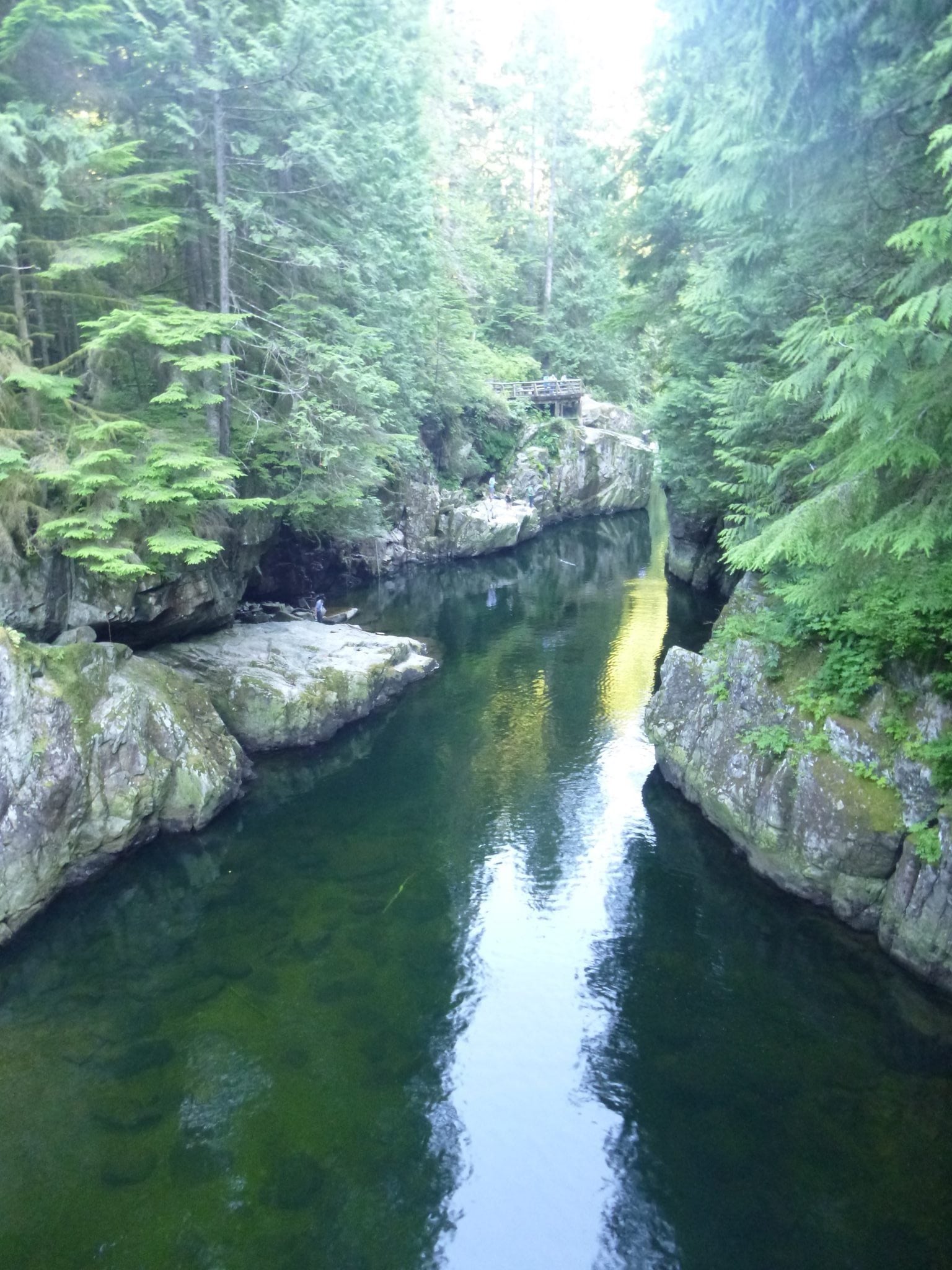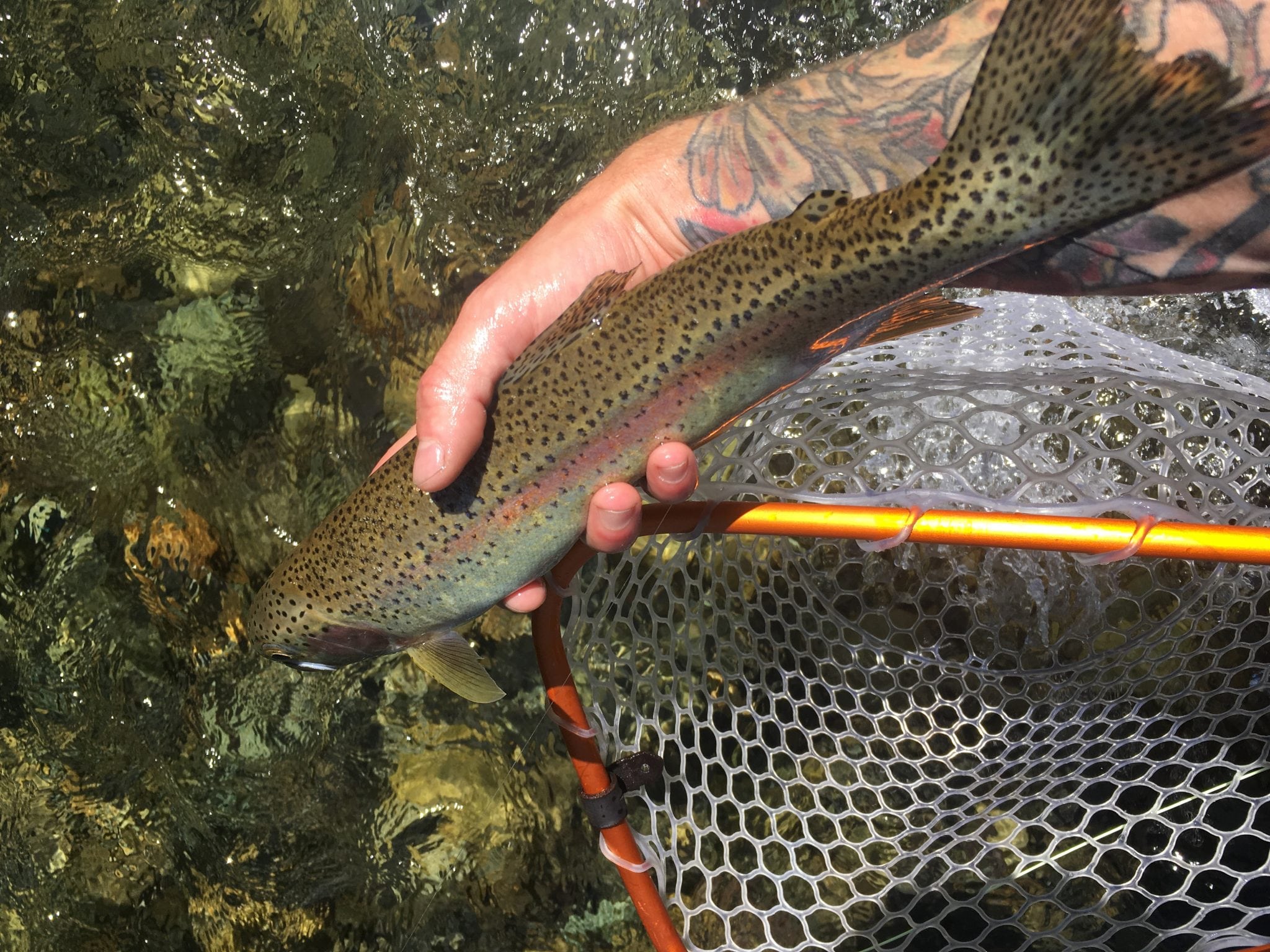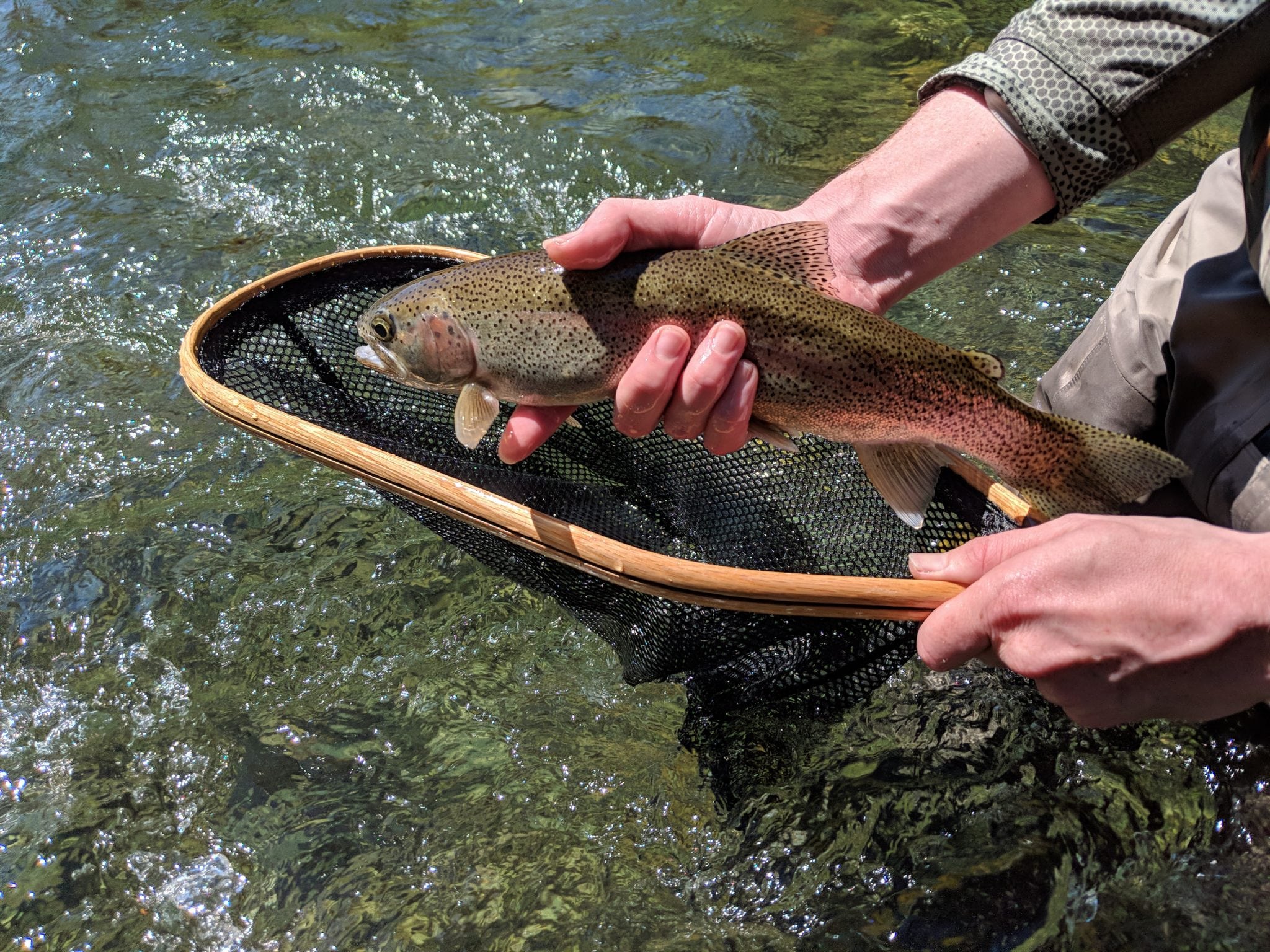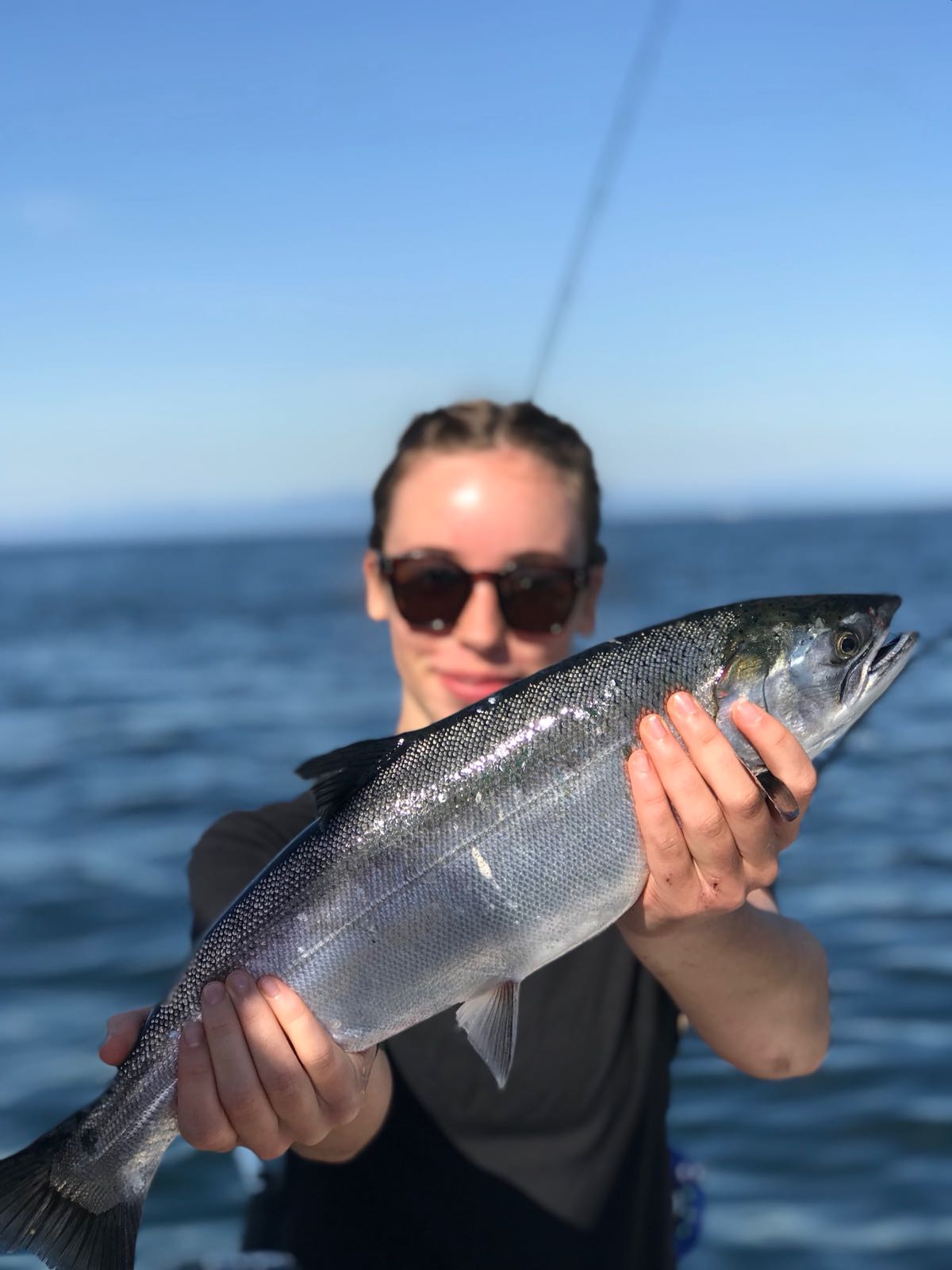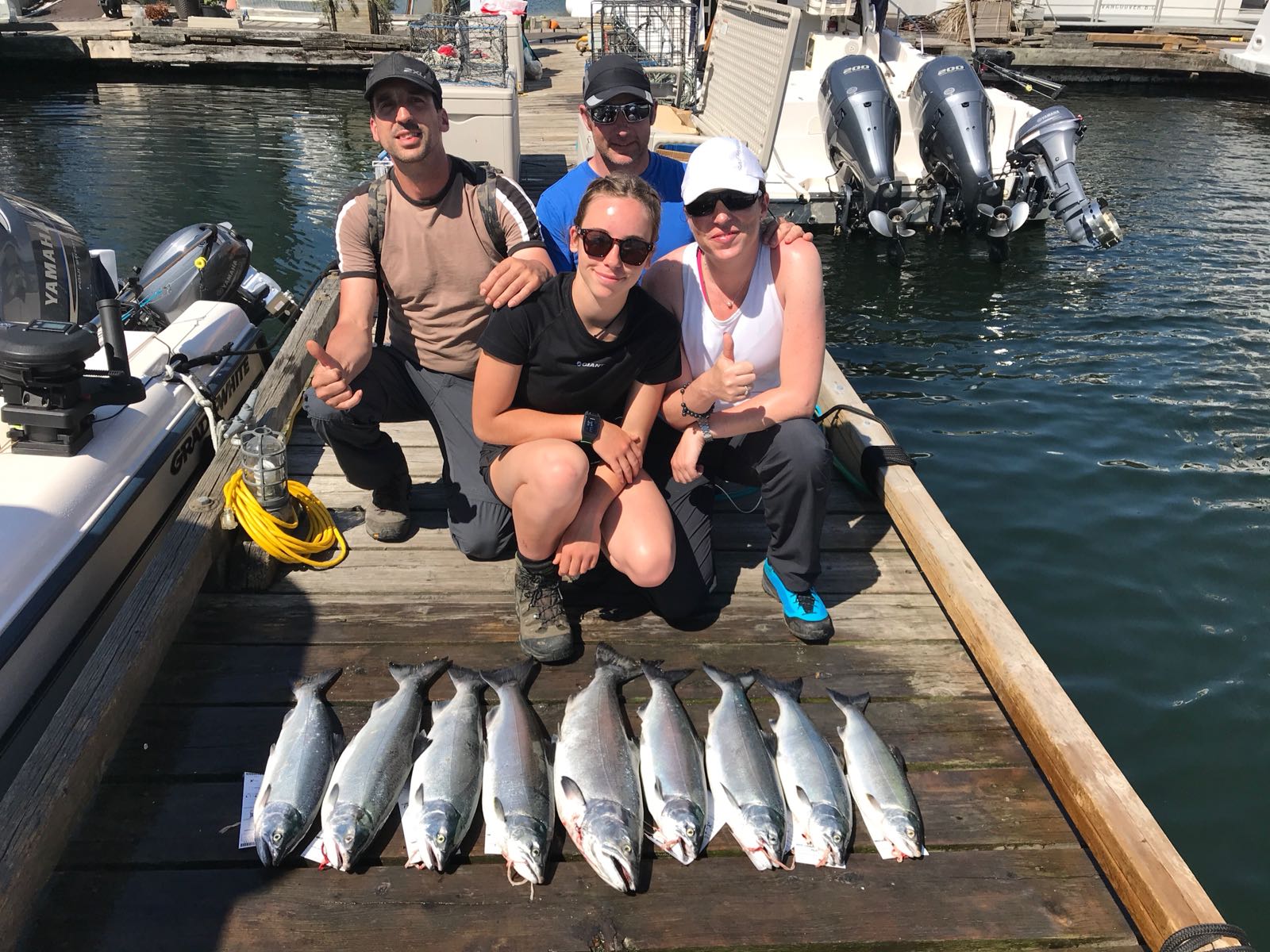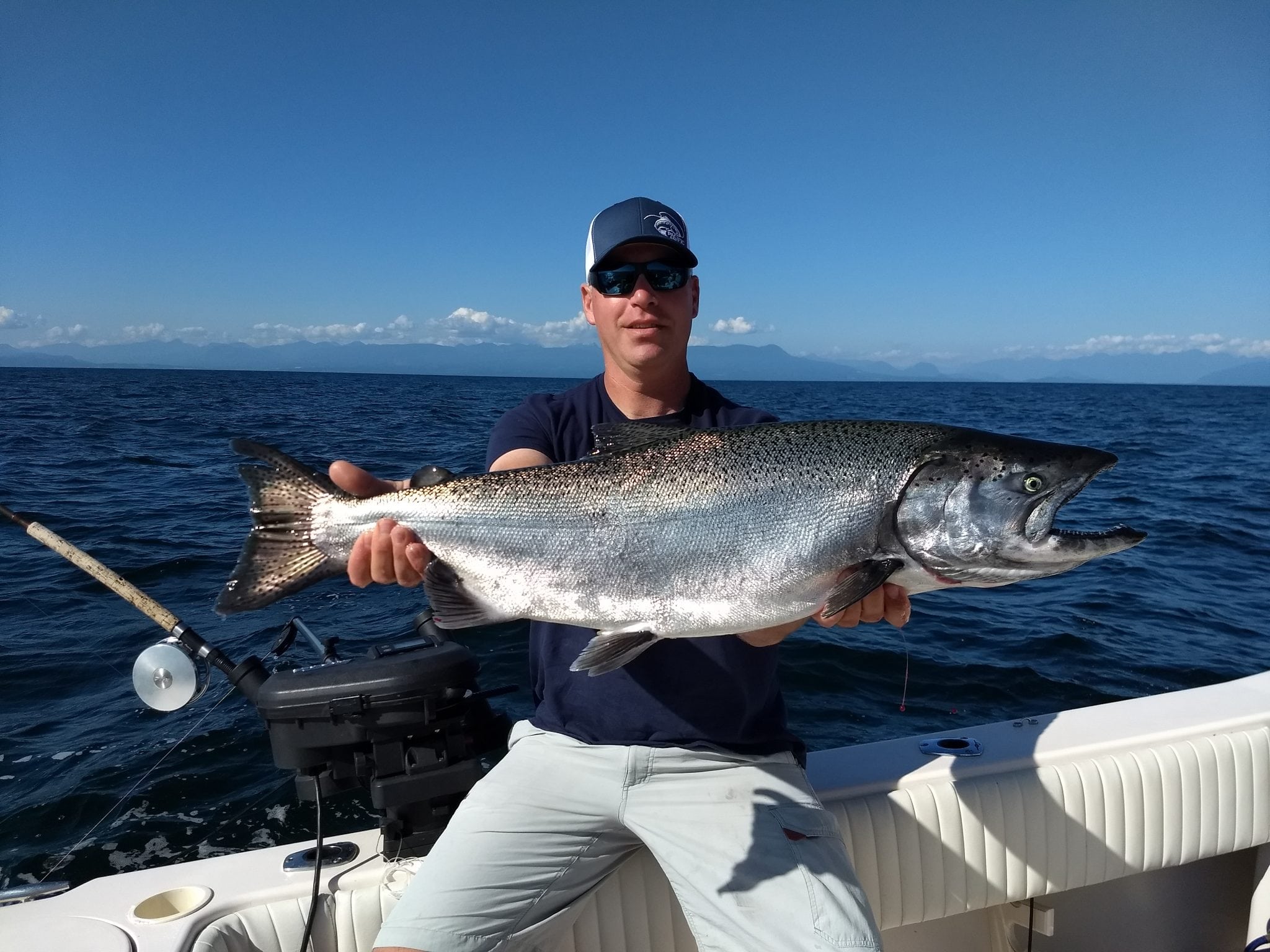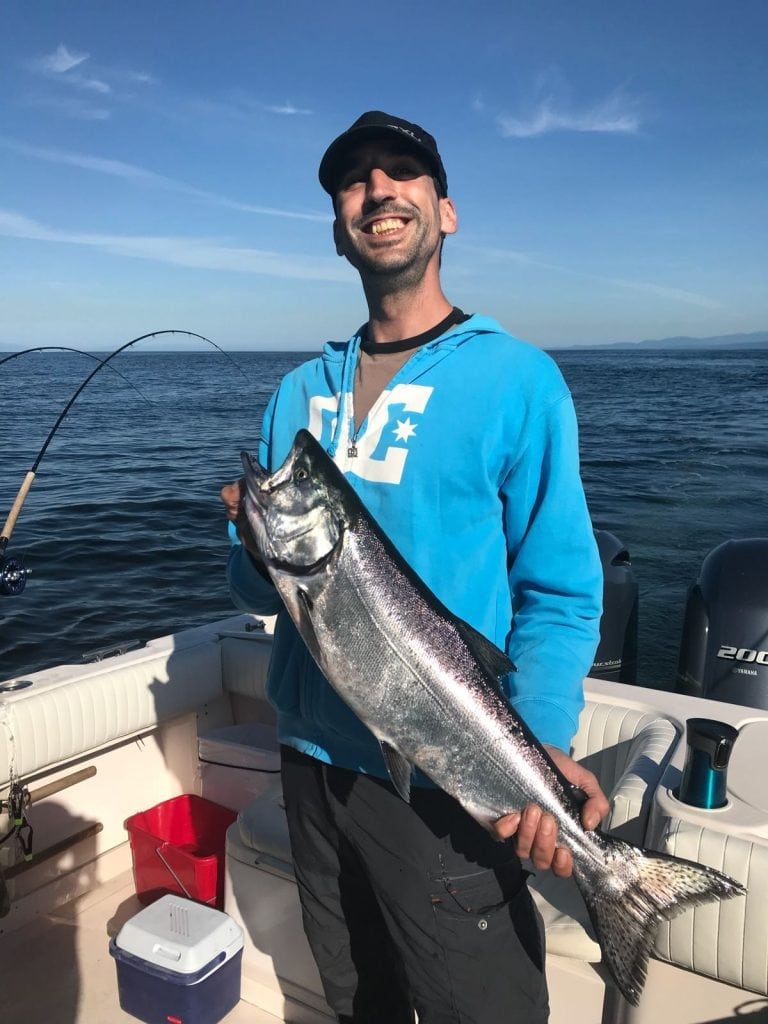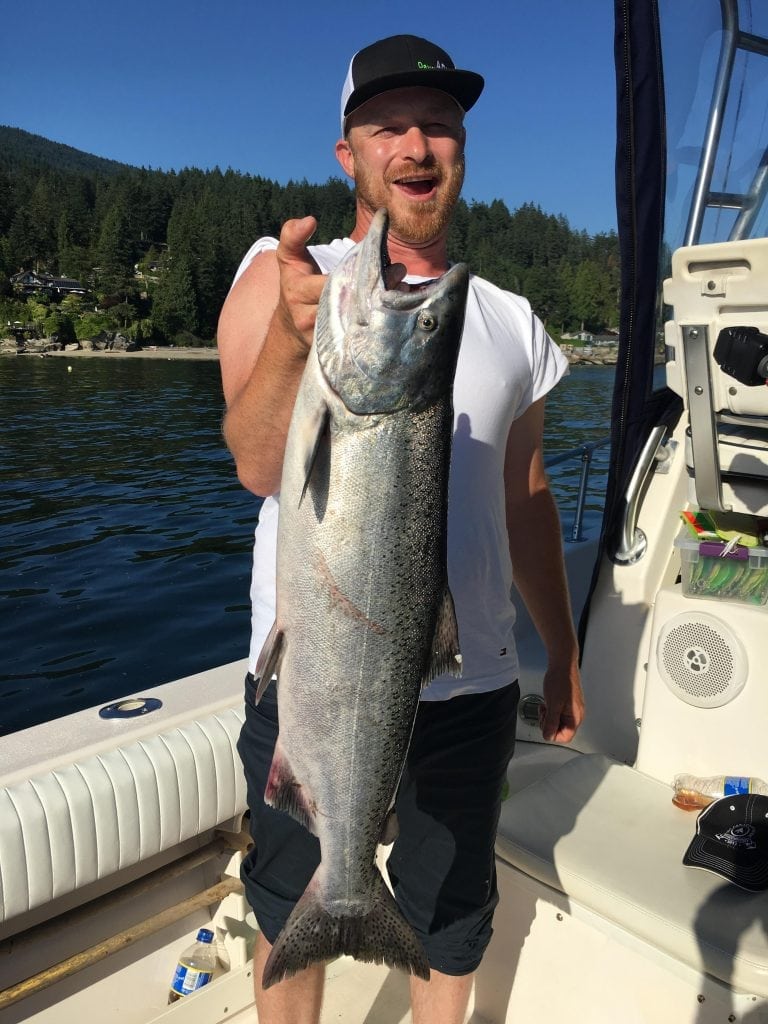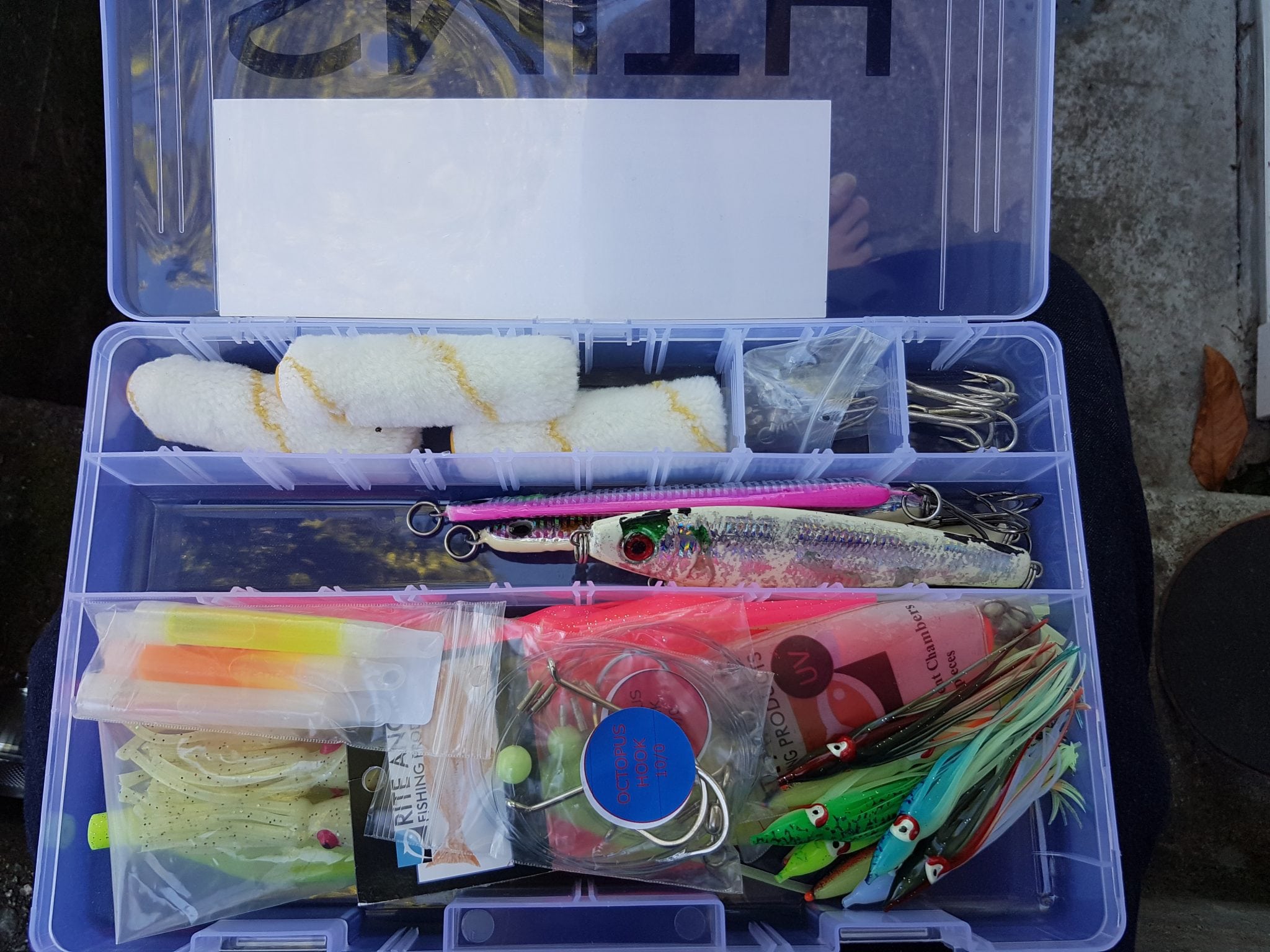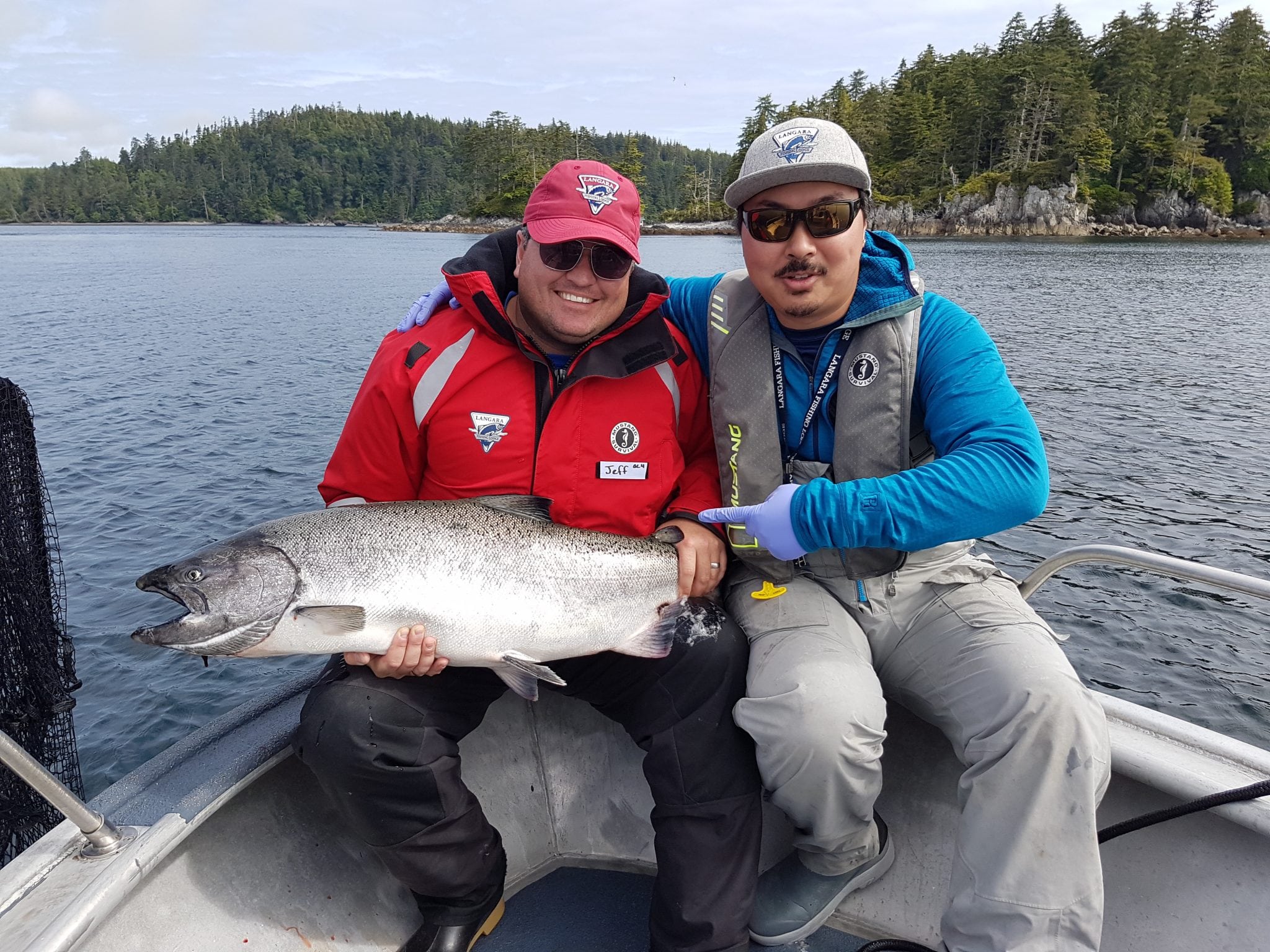OUTLOOK
Summer is in full swing and we are in for some more epic weather this week. Temps might even hit the 30 mark on Monday. What does this mean for fishing?
On the saltwater front high temps can sometimes mean wind but at least in the short term forecast it doesn’t look bad for the weekend with 5-15knots NW. Keep a close eye on the weather when heading out because things do change fast.
We have been hearing very good reports across the saltwater front and the beach fishing is picking up. Sun will make the fish go a little deeper and they might not come as close to shore, but coho fishing has been excellent, there are still lots of chinook opportunities and at least in the mornings before the sun hits the water beach fishing should be good. Check out Jason’s saltwater report and Andre’s beaching fishing report below.
On the river front we are hearing some more positive reports from the Vedder chinook fishery. The Capilano is still very low and we expect that to continue. You can see updates in the river sections below.
The Skagit and the Thompson are great opportunities for classic river fly fishing this time of year. Matt was out last weekend and if you missed it Brendan had an awesome report on the different bugs on the Skagit in last week’s report. This week, Matt has an update and a piece on what he puts in his pack for a Skagit trip. We also have some info on the Thompson River if you are venturing into the interior.
Last but not least we have another episode of Where in The World is Jordan Simpson. He just got back from a trip up to Langara guiding and has a fun play by play on his trip. It really lays out what a great trip to Haida Gwaii looks like. Check it out at the end of the report.
On to the report!
INDUSTRY EVENTS
Vancouver Chinook Classic 2018
Don’t hesitate to register for this year’s Vancouver Chinook Classic! This event sold out last year and we expect it will again this year. This is the premier, nonprofit catch and release salmon derby fundraiser for the Pacific Salmon Foundation & Sport Fishing Institute. We look forward to seeing everyone out on the water again this August – fishing and having fun in the sun competing for the large cash prizes!
Date: Sat Aug 18th & Sun Aug 19th 2018
Venue: Pacific Gateway Hotel & Deckside Marina (previously known as Pier 73 Marina)3500 Cessna Drive Richmond
Prizes: 1st place $15,000
2nd place $7,000 3rd place $3,000
Entry Fee: $300 + GST per person
Registration: To make registration easier we have created an online registration process. Register online here: https://www.decksidemarina.com/registration-form
Registration Includes:
- Entry into 2018 Vancouver Chinook Classic
- Complimentary moorage
- Breakfast Saturday & Sunday morning
- Dinner Saturday night
- BBQ and awards ceremony Sunday afternoon
- Drink tickets
- Discounted room rates at the Pacific Gateway Hotel
If you have any questions please give us Deckside Marina a call at 604-970-4882 or email info@decksidemarina.com
For more details have a look at tournament website www.vancouverchinookclassic.com
Thanks to all who participate, donate and support! We welcome all anglers from novice to expert and look forward to seeing everyone again soon – let the fun times begin!
Your VCC Derby organizers,
Pacific Angler
West Coast Fishing Club
Pacific Gateway Hotel
FRESHWATER FISHING REPORTS
Capilano River Fishing Report
We are not expecting any rain for the next few weeks and it looks like sun is in the forecast for quite some time. The water is very low and clear and the water temperature is rising due to the heat we are experiencing.
The fish are more skittish and they are not committing to lures. The good news is there are quite a few fish just staging in the pools and if presented at right and a perfect time, you can still hook these fish. There are some key things that causes the fish to be more wary – temperature, water level, water clarity and last but not least, angling pressure.
The water temperature plays a big role with the activeness of the fish. Thus people that are fishing the first light are more likely to have success. First light also solves the angler pressure issue because the fish have been rested all night long.
With water being low and clear, it is very important to downsize your lures as larger sized lures and flash will spook fish. Using size 2-3 Vibrax or 3/16 oz Croc is a good choice. Use more natural colours such as blues, greens and silvers. If they don’t react to standard steady retrieves try adding twitches and pauses into your presentation but note that big movements are more likely to scare them. Same for the twitching jigs. Don’t twitch it aggressively as there’s a high chance of foul hooking the fish and it will frighten the salmon in the pool.
As for the fly guys, use a fast full sinking line to get your presentation down. Natural coloured leech patterns, wooly bugger, small streamers and Cap bugger are good patterns to use with a slow twitchy retrieve.
Be careful of foul hooking fish and please try to protect any steelhead or any wild coho. Release them with care so that they may spawn without stress.
Stay safe out there,
Dustin Oh
Chilliwack River Fishing Report
This coming week is going to be a scorcher with some 30+ degree weather in the forecast! This will be a great week to be at the Chilliwack River; maybe not for fishing but it would make for a beautiful day out in the sun! There are a few red chinook kicking around and water conditions continue to be good so it is worth wetting a line, just be mindful of the fact that this run is small so it is more of a “hunt” than anything. With the clearer water you can downsize presentations once the sun comes up over the mountains and lights everything up. I still prefer to fish bigger at first and last light though. Pro-cured roe, prawn, colorado blades, and wool ties should be in every gear fisher’s arsenal right now. Fly guys bring your big salmon streamers and heavy sink tips as you will need to get down to them and present a gnarly pattern to elicit a reaction out of them. Fish lower down on the river as you will be more likely to come across fresh fish just coming into the system and these are the “easier” fish to catch.
If you do plan to fish the Vedder in the next while please keep an eye out for sockeye salmon by-catch. They are a fun fish to hook in a small clear river and will smash a well presented prawn under a float but keep in mind that they are strictly catch and release. Thus if you do get into a few please treat them with care.
Happy hunting!
Alex Au-Yeung
Skagit River Fishing Report
I hit the water last weekend and we had a ton of fun. The fishing was solid but comes with a couple warnings. The first warning is that the river is still high and there are a number of spots that are uncrossable. This makes a few of the access points an issue because there is simply not enough water to fish. The first spot we hit (one of my favorites) was like this and had to change the game plan after hiking in because there was only one small area to fish.
Don’t worry though with some exploring there are enough areas to make it worth going if you pick your access spots. If you were out last year think back to spot where you crossed. If there were at mid thigh depth last year, you will probably not be able to cross in the same spot right now. The river will continue to drop and I am hoping with this heat we should see lower water levels soon.
We nymphed quite a bit in the morning and hooking fish on the standard prince nymphs, golden stones and other mayfly and stonefly imitations. We stayed late hoping for a hatch but nothing of note came off. The interesting thing was that even though there were not a ton of insects on the water when we found rising fish we caught them. They were very hungry and not very picky. We hooked a half dozen fish on dries in the afternoon on standard grey mayfly imitations in a size 10-12.
When I head out I am lucky to have dedicated Skagit/trout fishing sling pack with all the essentials. I wanted to talk you guys and girls through what I carry because there are a number of key accessories that you will want to have.
First off, bug spray – I have an industrial bottle in the car and then a little bottle in my pack. The bugs were not bad on this last trip but there are bugs and if you leave the bottle in the car you will get eaten alive on your hike back to the truck at the end of the day. Sunscreen, Advil, small role of sports tape and a sunglass cleaning cloth are also always in my pack
I carry three rods with me. A 3wt rigged with a dry fly, a 4wt rigged with my custom nymphing leader, and a 5 or 6wt rigged with a sink tip for bulltrout. For dry fly fishing you will need floatant. I carry both the liquid and the dry shake. I find that the liquid is best to start off with and then the dry shake is best if your fly gets water logged or hooks a couple fish. I fish 3-4lb leaders on my three weight and I always carry a back up. On the nymphing rod I carry a selection of spit shot ranging from No.4 to the AB size. I like to have options here but if you were to get only one it would probably be the BB size. I then have 3-4 thing-a-ma-bobber indicators in my kit as they sometimes break.
In my nymphing kit I also carry tippet rings, small swivels and hook snaps. If I am really geek’n out with an advanced nymphing rig these pieces are useful. Here is a link to our advanced nymphing leader video Also, if you saw our egg nymphing video you can adapt this with a leader board and nymphs so you can make fast changes.
Lastly for my bulltrout rod I use a dedicated 10ft type 6 sink tip line but if you don’t have the luxury of a dedicated line, bring a 12ft 7ips versi leader. You can loop this on your floating line and if you see as bulltrout you can make a fast switch. On this setup I run 4ft of 8-10 lb tippet as leader.
For tippet and leaders, I carry backup 9ft 3.4lb 9ft 5lb and then I love the new fishpond headgate tippet spool tender. I load it with 3.4lb, 5lb, 8lb and 10lb mono and then 3lb, 5lb,7lb fluorocarbon. These seem to have me covered for most scenarios.
Obviously, I also carry pliers, forceps, nippers, a hook file, my trusty Moby net and a ton of flies.
Hope this helps when you are building a checklist for heading out on the water.
Remember the Skagit is catch and release only and like all rivers in our area you need to pinch down your barbs.
Good Luck!
Matt Sharp
Thompson River Report
The Thomspon is another great trout fishing option that is sometimes overlooked. We have been hearing a few mixed reports from the river and we wanted to include it in the report because it is a great option for fly fishing over the next few weeks.
Right not we are seeing high water and it is not at ideal fishing levels yet, but we expect it to come into shape around the end of the month and it is worth putting on your list. If you haven’t fished this system before it is unique. It is a massive desert river. The water is hot, and you can easily fish it without waders. The dry heat is also good because there are way less mosquitos when compared to the Skagit. We fish it with large hopper style dry flies and larger stonefly nymphs. The fish are not always big but there can be some very large rainbows in this system that will surprise you. If you are debating heading out come down to the shop and we can help with the right flies and some general access points.
Matt Sharp
SALTWATER FISHING REPORT
Vancouver Saltwater Salmon Fishing Report
Well it’s the back end of July and there is a lot going on, so I think this week I am going to break it down by coho, chinook and sockeye
Coho:
It’s official; we are currently experiencing the best coho fishing in the Strait of Georgia since the mid 90’s. Lots of wild fish and lots of hatchery fish. For us the most productive spot has been out on the Hump. Just get out there and cover water and you will do well. The fish are basically in the top 60 feet of the water column so we are generally fishing 80 feet or shallower on the riggers, with plenty of fish up shallow. Wednesday I had one rigger at 57 with a 25 spread and caught lots of fish on my top rod and it was rough water conditions and dark and overcast. On the sunny and calm days the lower rods will do a bit better. White hootchies and white hootchies with some pink or red are producing well with a short leader around 26-28 inches. Purple flashers have been hot, like the Purple Onion in glow or non-glow, and Purple Haze flashers. Betsy flashers are also working well.
I was talking to Tom, one of our guides, on the dock yesterday as he was telling me about a great charter and a limit of coho. The stand out point of the story was when he was telling me about watching a coho repeatedly attack his chartreuse cannonball at the side of the boat while he was getting ready to set his gear. This is a good example of how shallow the fish are and how aggressive they are. These are the kind of stories you expect from the Gwaii or Tofino, but it is happening right now in our won back yard. Without a doubt you could be bucktailing for these fish. There are all sorts of “lost” coho techniques that we just haven’t used locally over the past 20 years as the coho numbers haven’t been around to justify it, but they are back this year, so dust off the light rods and the bucktails and get out there. We have lots of bucktails and other coho flies at the shop, including some spinner blades to put in front of them.
Chinook:
We are having some great action off Gabriola and Nanaimo for chinook. The fish are there; it is just a matter of getting over to them. The NW winds have made that pretty tough this past week, but we did manage to make it across on a few days.
As per the last month or so, the fish are generally very close to bottom, feeding on herring, so that is where you gear needs to be. Chartreuse glow and green glow flashers have been very productive, like the Phantom, BC, Salty Dawg, Lemon Lime, and STS. Use a 28-32 inch leader to a glow green or chartreuse hootchy like a splatter back or just a pure glow hootchy. We have lots of these hootchies in stock at the shop and they are the ones we are using on the guide boats.
We haven’t been focusing too much on the chinook closer to home as the coho fishing has been so good. That is going to change this next week though. We always see the chinook fishing pick up a bit in the next 2 weeks as more and more Fraser fish start to show up and we will be ready for that. Some of my friends have already caught a fair number of chinook off the Bell Buoy and the North Arm and there have been some fish taken off the South Arm as well. It is not closed, just so we are all clear on that. The same lines that were in place last year are in place this year, so plot the lines and stay outside of that and you are good to go (plot a line from N Arm Jetty to S Arm Jetty). The exact lines, descriptions, and co-ordinates are on the DFO site.
Remember these Fraser fish are shallow so hot depths are generally 75 feet or shallower on the downrigger. Bait is king, so we fish anchovies or herring on all 4 rods for this fishery. UV green or purple teaser heads, or chrome teaser heads on the top rods and glow chartreuse or green teaser heads on the bottom rods. Same system with your flashers, Betsy, Green Onion Glow, Purple Onion Glow on the top rods, and glow flashers on the bottom rods like Salty Dawg, BC, STS, Lemon Lime, Phantom, Madi.
Sockeye:
The sockeye are showing up, we have seen some jumpers and there are reports of some in the Fraser as well. The 50% probability forecast is 13.8 million fish. If we get that many we are going to see an opening. The early fish are always the smaller component of the run and are protected, as are the Cultus Lake fish, so there is never an opening until these fish have moved through and we get into the mid summer and later summer components of the run. This means we generally get an opening about mid August, usually on a weekend, so maybe we will see it open around August 18th. There are a lot of rumors that it is going to open, but I can tell you right now it has to do with the data they are getting as they do test sets on the approach areas. We are way to early for that data yet, so the rumors are just that. So for now, we have to sit back and wait and see. If the fish show up in good numbers it will open, if they don’t it won’t, it’s that simple. We won’t know more until the beginning of August.
Crabbing:
Well it is finally slowing down as the commercial has taken its toll, but we can’t complain as it was surprisingly good through most of July.
Beach Fly Fishing Report
The tides are looking great this week for the next ten days starting on Saturday the 21st. There is minimal rain in the weather forecast so we expect the Capilano River levels to remain low. Our guide boats have been catching a lot of coho offshore from the estuary, so this is a good sign that more coho are on the way. They have caught a few that were bigger than average for this time of year so hopefully they will accumulate at the estuary for the rest of the summer.
There are fish in the estuary already, but you have to be patient and wait for them to show. Don’t rely on jumpers so much, sometimes the jumping fish are the ones who have been at the river mouth for some time and are stale. Finning fish are my favorite but keep your eyes on the water and look for any disturbance on the surface and then cast you lure or fly to the area of “nervous” water. If you can determine the direction they are swimming, cast ahead of the pod and bring your offering into them. Try to cast well in front of them and remember it is not always a fast strip, sometimes all it takes a little twitch or one long pull to get their attention.
Good luck and see you on the beach.
Andre Stepanian
Where in the World is Jordan Simson – Langara Trip Update
After getting up early and grabbing the required Breakfast of Champions from McDonalds, I checked in to my flight with the other guides headed to Langara Fishing Lodge at YVR South. After a short flight to Masset, we transferred to our Heli Jet flights and headed to the lodge. The scenic 15-20 minute flight did not disappoint, and we were treated to watching the humpback whales play and other fishing boats try to get their catch.
That first afternoon, after meeting my guests, we headed out to the fishing grounds and dropped our lines. We didn’t have to wait long until we were in to our first salmon. From then on, we ran around the boat like crazy, trying to get four rods down. Between the coho and chinook, we had our pick of size and eventually got our daily limit.
With our limit caught and the rest of the afternoon flood tide to play with we switched to bottom fishing. We hit an area called The Nub and dropped our Kodiak Jigs. With a light coating of Smelly Jelly, the jigs only had to do a couple hops before the first of many ling cod were hooked up and boated. Quickly getting my guests limit, we dropped again to get me a couple to take home as well.
Moving from the line we were working, I put us over a different line and dropped the jigs back down. A couple hops later and we were in to our halibut. Four drops resulted in three turkey-sized fished, allowing my guests to selectively harvest their catch.
With the salmon and bottom fishing done, we opted for an evening whale show before heading in to some food and drinks.
Up at 3:30am the next morning, I got my boat and myself ready for my guests. With all the rods rigged and baited with some tasty cut-plugs, I met my guests and gave them an option: We can either go back to the same spot and play with many standard-issue chinooks (12-16lbs), or go to a certain area and not get as many (or none at all), but if we did get one, it would be a big one.
They opted for the latter option.
Dropping in next to the kelp in 30′ of water, I set my rods to only 7, 9, 11, and 13 pulls. In terms of depth, each pull is only about two feet, making my verticals 14, 18, 22, and 26 feet. With the mooching angle, it’s even shallower, probably by a couple feet each.
Seeing Morgan in his boat ahead of me just lose a fish, I had a feeling a few were squirting through on the push. It wasn’t long until my guest, Jeff, was in to his first. It looked to be a fish a in the low-twenties, but we lost it near the boat. That was it for the next few hours.
With the flood dying down and starting to slack, I wanted to move. I told the guys we could go to a similar spot, that would produce similar chances, but we needed to go now to set up for the first push of the ebb. We collectively decided to go, and reeled up. Dropping in to the next spot a little farther down the shoreline, I was hoping to intercept fish that we might have missed at the fist spot that would be moving through on the ebb push.
Putting the baits down shallow until they were just barely intermittently visible as they spun around, we didn’t have to wait too long until the first fish hit.
Telling my guests ahead of time that the fish don’t bite at this location, but rather smash and run, the rod went from the classic mooching angle to under the boat in a fraction of a second. Getting the fish under control, we eventually boated a healthy fish of 19lbs. After settling down, we saw how we had drifted during the fight. Moving up the shore and back in to position, we dropped the baits again. This time it was the back right rod to get hit. The fish was on briefly as it corked the rod and peeled line. Struggling to get the loaded rod out of the holder, Sal missed the fish.
With the other three rods still down, I reset the bait and dropped it down into the ripping current.
“FRONT RIGHT! FRONT RIGHT- TIP UP, TIP UP! GET IT NOW” I shouted with excitement as the second-shallowest rod slammed down. With the rod halfway under the boat and bouncing, the Abel moocher started to scream. Eventually getting the rod out of the now sideways rod holder, Jeff got the tip up just in time as the fish made a huge run. Bringing up the other rods, we spun out in to the pass and drifted with the fish. Finally getting over the fish, Jeff played it like a pro, letting it make its big runs with the current as needed. Knowing this was ‘The One’ we came looking for, we kept our cool. Finally seeing it flash under the boat, we knew this might be the big fish release we had talked about at the beginning of our trip yesterday. Finally the fish turned it’s head up and started to hover on it’s side- that’s when we saw it’s size. Grabbing the measuring tape in preparation, we eventually netted the fish and had it next to the boat in the water. As we were getting ready to tape it for measuring and release, we noticed that it was bleeding heavily. With hopes that it would stop, we continued to measure its girth and length. During this process, it was evident this fish would expire and that releasing it would not be an option. Taped out, the fish was 30.8lbs, but once on the scale, weighed in at 33lbs.
We decided that the 19lb fish and the 33lb attempted release were good enough, so we headed in for lunch. Afterwards, we head up top to look for coho and finish off our bottom fishing.
The rest of the trip was similar, with each day and tide being used to target different fish.
On the last morning, my guests and I got to sleep in until 630am, had a relaxing breakfast, and then boarded our heli-jets. Back to Masset we went, then on to Vancouver.
This trip proved to be a great few days, with lots of whales, sun, salmon, and halibut. The only thing that this trip was short on was sleep.
Jordan Simpson


